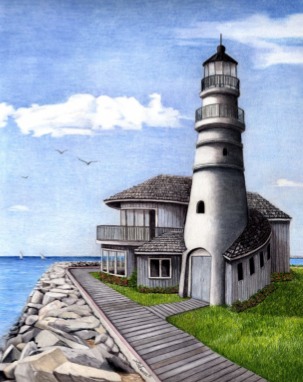“Live in Dana Point! Year-round Golf …Yachting…Bathing …Fishing…Tennis…Horseback Riding…Polo…Motor Boating…Aquaplaning. Dana Point is destined to become the foremost seashore colony of California. Capitalize on this unprecedented opportunity for investment where increasing values are assured.”
And there it stood in the artist’s rendering: at the top of the promontory, majestic in scope and romantic in spirit. It was the lighthouse that Community Developer S.H. Woodruff envisioned almost a century ago. Oh, sure, the light structure was to be part of a hotel, but there it would have been nonetheless, guiding ships safely into and past the recreational waters below. Even the skeptics of the day probably did not doubt its inevitability. Who could have known that Woodruff’s dream was to end up on the rocks, just another victim of the stock market crash of 1929?

It was not until 1995 that the dream was revived, this time by Dana Point realtor Ed Guy. After all, Guy must have reasoned, the Headlands was still undeveloped. The community could still have its lighthouse. The harbor below had existed for over 30 years. The time was ripe for the community to make the most of this historic opportunity.
Ed Guy began a letter writing campaign to the Dana Point News and to the Dana Point Planning Commission. He was joined by another local resident, John Gile.
Even when, in 1996, the Headlands Reserve LLC purchased the 121-acre bluff for the purpose of constructing 125 luxury homes, the lighthouse plan still seemed feasible. There would be public amenities accompanying this development. The beacon light was just the thing. The spirit of Richard Henry Dana would be proud.
Yes, Richard Henry played an important role in the Dana Point dream of 1996, just as he had in the Woodruff dream of the 1920s. It would be stretching the credibility of the vision to suggest that seaman Richard Dana was the first to imagine a friendly beacon as he stood lonely watch aboard the Pilgrim one star-filled night sailing south past the bluffs of San Juan Campestrano.
It is fact, however, that 24 years after his first visit to California in 1835, Dana returned to the Pacific Coast. He wrote of this visit in a chapter entitled “Twenty-four Years After”, an addendum to the book Two Years
This final chapter begins with a description of San Francisco when Dana first visited there. “It was in the winter of 1835-6 that the ship Alert, in the prosecution of her voyage for hides on the remote and almost unknown coast of California, floated into the vast solitude of the Bay of San Francisco. All around was the stillness of nature. One vessel, a Russian, lay at anchor there, but during our whole stay not a sail came or went. Our trade was with remote missions, which sent hides to us in launches manned by their Indians.”
Note the contrast in Dana’s description of the same area 24 years later. Note, as well, the role that lighthouses played in creating this fantastic scene.
“On the evening of Saturday, the 13th of August, 1859, the superb steamship Golden Gate, gay with crowds of passengers, and lighting the sea for miles around with the glare of her signal lights of red, green, and white, and brilliant with lighted saloons and staterooms, bound up from the Isthmus of Panama, neared the entrance to San Francisco, the great centre of a world-wide commerce. Miles out at sea, on the desolate rocks of the Farallones, gleamed the powerful rays of one of the most costly and effective light-houses in the world. As we drew in through the Golden Gate, another light-house met our eyes, and in the clear moonlight of the unbroken California summer we saw, on the right, a large fortification protecting the narrow entrance, and just before us the little island of Alcatraz confronted us–one entire fortress. We bore round the point toward the old anchoring-ground of the hide ships, and there, covering the sand-hills and the valleys, stretching from the water’s edge to the base of the great hills, and from the old Presidio to the Mission, flickering all over with the lamps of its streets and houses, lay a city of one hundred thousand inhabitants.”
The dream of Ed Guy and John Gile and the Dana Point Lighthouse Society is considerably more modest than this description of San Francisco, more modest, even, than that of S. H. Woodruff. “The lighthouse that we propose would be a functional lighthouse,” Gile explained to those attending the H.S. monthly meeting in April. “With a light as a navigational aid,” he added. This 65 foot tower would be attached to a 2,500 square foot, two story building for community gatherings.
“There’s something about a lighthouse that has a sentimental appeal to it, standing there like a sentinel protecting everything. It’s a welcome to those coming in and a nice handshake going back out. People like to visit lighthouses. People like to get married near lighthouses. It’s a romantic thing.”
It has now been 14 years since Ed Guy began his campaign. The realization of the dream, in many ways, seems more remote than ever even though there have been times along the way when it seemed that success might be only a couple of years off. The story of prolonged negotiations with the California Coastal Commission, the County of Orange, and the City of Dana Point is a frustrating one, with protection of a tiny pocket mouse playing as important a role as financing and of gaining the support of those who own and operate the harbor itself.
